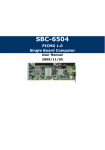Download 1971.4KB - Axiomtek
Transcript
SHB110 Series ™ ™ Intel Core 2 Duo / Core Duo ™ Core Solo / PICMG 1.3 Full-Size Single Board Computer User’s Manual ® Disclaimers This manual has been carefully checked and believed to contain accurate information. AXIOMTEK Co., Ltd. assumes no responsibility for any infringements of patents or any third party’s rights, and any liability arising from such use. AXIOMTEK does not warrant or assume any legal liability or responsibility for the accuracy, completeness or usefulness of any information in this document. AXIOMTEK does not make any commitment to update the information in this manual. AXIOMTEK reserves the right to change or revise this document and/or product at any time without notice. No part of this document may be reproduced, stored in a retrieval system, or transmitted, in any form or by any means, electronic, mechanical, photocopying, recording, or otherwise, without the prior written permission of AXIOMTEK Co., Ltd. CAUTION If you replace wrong batteries, it causes the danger of explosion. It is recommended by the manufacturer that you follow the manufacturer’s instructions to only replace the same or equivalent type of battery, and dispose of used ones. ©Copyright 2008 AXIOMTEK Co., Ltd. All Rights Reserved May 2008, Version A3 Printed in Taiwan ii ESD Precautions Computer boards have integrated circuits sensitive to static electricity. To prevent chipsets from electrostatic discharge damage, please take care of the following jobs with precautions: Do not remove boards or integrated circuits from their anti-static packaging until you are ready to install them. Before holding the board or integrated circuit, touch an unpainted portion of the system unit chassis for a few seconds. It discharges static electricity from your body. Wear a wrist-grounding strap, available from most electronic component stores, when handling boards and components. Trademarks Acknowledgments AXIOMTEK is a trademark of AXIOMTEK Co., Ltd. ® Windows is a trademark of Microsoft Corporation. Phoenix & AWARD are trademarks of Phoenix Technology Ltd. IBM, PC/AT, PS/2, VGA are trademarks of International Business Machines Corporation. ® ™ ™ ™ Intel Core 2 Duo/ Core Duo/Core Solo are trademarks of Intel Corporation. Winbond is a trademark of Winbond Electronics Corp. Other brand names and trademarks are the properties and registered brands of their respective owners. iii Table of Contents Disclaimers ........................................................................................................... ii ESD Precautions ................................................................................................. iii Chapter 1 Introduction .................................................................... 1 1.1 1.2 1.3 1.4 Specifications .......................................................................................... 2 Utilities Supported ................................................................................... 3 Block Diagram ......................................................................................... 4 I/O Bracket .............................................................................................. 4 Chapter 2 Jumpers and Connectors ............................................. 5 2.1 2.2 2.3 Board Dimensions ................................................................................... 5 Board Placement..................................................................................... 6 Jumper Settings ...................................................................................... 7 2.3.1 COM2 Mode Select Jumpers: JP2, JP3, JP4 ................................... 7 2.3.2 LVDS Voltage Setting Jumper: JP1 .................................................. 8 2.3.3 Compact Flash Setting Jumper: JP6 (Optional)................................ 8 2.3.4 CMOS Clear Jumper: JP7 ................................................................ 9 2.4 Connectors ............................................................................................ 10 2.4.1 Printer Port Connector: PRN1 ........................................................ 11 2.4.2 Audio Output Connector: AUDIO1 ................................................. 12 2.4.3 CD AUX IN Connector: AUX1 (4 pin) ............................................. 12 2.4.4 ATX 4 Pin 12V In Connector: CN1 ................................................. 12 2.4.5 Serial Port Interface Connectors: COM1, COM2 ........................... 13 2.4.6 Floppy Disk Port Connector: FDD1 ................................................ 14 2.4.7 IDE Interface Connector: IDE1....................................................... 14 2.4.8 LVDS Panel Connector: CN3 ......................................................... 15 2.4.9 LCD Inverter Power Connector: CN2 ............................................. 17 2.4.10 CRT Connector: CN4 ..................................................................... 17 2.4.11 SATA Connectors: SATA1~2 ......................................................... 18 2.4.12 Ethernet Connector: LAN1/LAN2 ................................................... 18 2.4.13 USB Port Connectors: USB1~2 ..................................................... 19 2.4.14 USB Connector: USB3/USB4......................................................... 19 2.4.15 Front Panel Connector: CN5 .......................................................... 20 2.4.16 Mouse/Keyboard Connectors: MS1/KB1....................................... 21 2.4.17 System Fan1/Fan 2 Connectors: FAN1/FAN2 ............................... 21 2.4.18 CPU Fan Connector: FAN3............................................................ 21 Chapter 3 Hardware Installation .................................................. 23 3.1 3.2 3.3 Installing the Porcessor ......................................................................... 23 Installing CPU Cooler ............................................................................ 24 Installing the Memory ............................................................................ 26 Chapter 4 Hardware Description.................................................. 27 4.1 4.2 4.3 4.4 iv Microprocessors .................................................................................... 27 BIOS...................................................................................................... 27 System Memory..................................................................................... 27 I/O Port Address Map............................................................................ 28 Chapter 5 Phoenix-Award BIOS Utility........................................ 29 5.1 5.2 5.3 5.4 5.5 5.6 5.7 5.8 5.9 5.10 5.11 5.12 5.13 5.14 5.15 5.16 Entering Setup....................................................................................... 29 Control Keys .......................................................................................... 30 Getting Help .......................................................................................... 30 The Main Menu ..................................................................................... 31 Standard CMOS Setup Menu................................................................ 32 Advanced BIOS Features...................................................................... 35 Advanced Chipset Features .................................................................. 39 Integrated Peripherals ........................................................................... 40 Power Management Setup.................................................................... 45 PnP/PCI Configuration Setup................................................................ 48 PC Health Status................................................................................... 50 Load Fail-Safe Defaults......................................................................... 51 Load Optimized Defaults ....................................................................... 52 Set Supervisor/User Password ............................................................. 52 Save & Exit Setup ................................................................................. 53 Exit Without Saving ............................................................................... 54 Chapter 6 Installation of Drivers .................................................. 55 6.1 6.2 6.3 6.4 Installing Chipset Driver ........................................................................ 55 Installing VGA Driver ............................................................................. 58 Installing LAN Driver.............................................................................. 62 Installing Audio Driver ........................................................................... 64 Appendix A Watchdog Timer ..................................................... 67 Appendix B Configuring SATA for RAID Function .................. 69 v MEMO vi SHB110 Socket M Full-Size SBC User’s Manual Chapter 1 Introduction The SHB110 PICMG 1.3 full-size Single Board Computer supports ® ™ ™ ™ Intel Core 2 Duo/ Core Duo/Core Solo processors with FSB ® 533/667 MHz. The board integrates chipsets Intel 945GME and ICH7M-DH that deliver outstanding system performance through highbandwidth interfaces, multiple I/O functions for interactive applications and various embedded computing solutions. There are two DDR2 DIMM sockets for dual channel DDR2 533/667, maximum memory capacity up to 4GB. The board also features Ethernet 10/100/1000Mb, dual PCI-Express LAN, and two serial ATA channels for a tatal of two serial ATA hard drives at maximum transfer rate up to 3Gb/s. Four USB 2.0 Port and built-in high definition audio codec can achieve the best stability and reliability for industrial applications. Introduction 1 SHB110 Socket M Full-Size SBC User’s Manual 1.1 Specifications ® ™ 2 Duo/ Core ™ Duo/Core ™ z CPU: Intel Core processors z System Chipset: Intel 945GME and ICH7M-DH z CPU Socket: Socket M z Front-Side Bus: 533/667 MHz z BIOS Solo, ® Award PnP Flash BIOS System Memory Two x 240-pin DDR2 DIMM sockets Maximum up to 4GB DDR2 memory z Note The actual maximum capacity will be less depending on system configuration. Support DDR533/667 memory z L2 Cache: integrated in CPU z IDE Interface One IDE connector and up to two IDE devices, Ultra DMA ATA33/66/100 supported z FDD Interface Supports up to two drives z Compact Flash Socket (optional) ® One Compact Flash Type II Socket z Onboard Multi-I/O Parallel Port: one bi-directional with ECP/EPP/SPP support Serial Port: one for RS-232 (COM1) and one port for RS-232/422/485 (COM2) z USB Interface Four USB ports compliant with USB Spec. Rev. 2.0 z VGA Controller 2 ® ® Intel Graphic Media Accelerator 950 integrated on Intel Introduction SHB110 Socket M Full-Size SBC User’s Manual 945GME z Ethernet The LAN1/LAN2 is 82573L Ethernet controller support 10/100/1000 Mb Dual PCI-Express LAN z Serial ATA Support Serial ATA/Serial ATA II Two Serial ATA channels for a total of two Serial ATA hard drives Maximum transfer rate could up to 3Gb/s z Audio Realtek ALC203 Audio Codec onboard z Hardware Monitoring Detection of CPU temperature, System temperature, Power failure and Fan speed z Watchdog Timer Reset Support (1-255 level) z Dimensions: 338x 126mm (8 layer) NOTE All specifications and images are subject to change without notice. 1.2 Utilities Supported ® z Intel 945GME Utility and Drivers z VGA Drivers Ethernet Utility and Drivers Audio Utility and Drivers z z Introduction 3 SHB110 Socket M Full-Size SBC User’s Manual 1.3 Block Diagram Notice: 4 USB 2.0 Port built-in on Backplane 1.4 4 I/O Bracket Introduction SHB110 Socket M Full-Size SBC User’s Manual Chapter 2 Jumpers and Connectors 2.1 Board Dimensions Jumpers and Connectors 5 SHB110 Socket M Full-Size SBC User’s Manual 2.2 6 Board Placement Jumpers and Connectors SHB110 Socket M Full-Size SBC User’s Manual 2.3 Jumper Settings Proper jumer settings configure the SHB110 to meet your application purpose. 2.3.1 COM2 Mode Select Jumpers: JP2, JP3, JP4 These jumpers select the COM2 port’s communication mode to operate RS-232 or RS-422/485. Description Function COM2 Jumper Setting RS-232 (Default) JP2 JP3 JP4 RS-422 JP2 JP3 JP4 RS-485 JP2 JP3 JP4 Jumpers and Connectors 7 SHB110 Socket M Full-Size SBC User’s Manual 2.3.2 LVDS Voltage Setting Jumper: JP1 This Jumper is to select the voltage for LCD interface. Description Function LCD Voltage 3.3V (Default) Setting 5V Jumper Setting JP1 JP1 2.3.3 Compact Flash Setting Jumper: JP6 (Optional) Use this jumper to set Master/Slave Compact Flash interface. Description Function Compact Flash Setting 8 Jumper Setting Master (Default) JP6 Slave JP6 Jumpers and Connectors SHB110 Socket M Full-Size SBC User’s Manual 2.3.4 CMOS Clear Jumper: JP7 You may need to use this jumper is to clear the CMOS memory if incorrect BIOS settings. Description Function CMOS Clear Normal (Default) Clear CMOS Jumpers and Connectors Jumper Setting JP7 JP7 9 SHB110 Socket M Full-Size SBC User’s Manual 2.4 Connectors Connectors connect this board with other parts of the system. Loose or improper connection might cause problems. Make sure all connectors are properly and firmly connected. Here is a summary table shows you all connectors on the board. Function Audio Output AUX IN Connector AUDIO1 AUX1 Function Connector FDD FDD1 P-ATA IDE IDE1 KB1 Battery Socket BT1 K/B connector ATX 4P 12V IN (Option) CN1 LAN1 RJ-45 LAN1 LCD Inverter Power CN2 LAN2 RJ-45 LAN2 LVDS Panel Connector CN3 M/S connector MS1 CRT Connector CN4 Printer Port PRN1 Axiom Front Panel CN5 S-ATA Port1 SATA1 COM1 COM1 S-ATA Port2 SATA2 COM2 COM2 CPU Socket U12 DDR2 DIMM Slot 1 DDR1 USB Port 1 USB1 DDR2 DIMM Slot 2 DDR2 USB Port 2 USB2 System FAN1 FAN1 USB Port 3, 4 USB3 System FAN2 FAN2 CPU FAN FAN3 CF Slot 10 CF1 Jumpers and Connectors SHB110 Socket M Full-Size SBC User’s Manual 2.4.1 Printer Port Connector: PRN1 Print Port Connector [Default] This board has a multi-mode parallel port to support: 1. Standard Mode: IBM PC/XT, PC/AT and PS/2™ are compatible with bi-directional parallel port. 2. Enhanced Mode: Enhance parallel port (EPP) is compatible with EPP 1.7 and EPP 1.9 (IEEE 1284 compliant). 3. High Speed Mode: Microsoft and Hewlett Packard extended capabilities port (ECP) is IEEE 1284 compliant. Pin Signal Pin PRN1 Signal 1 2 1 Strobe# 2 Data 0 3 Data 1 4 Data 2 3 4 5 6 7 8 9 10 5 Data 3 6 Data 4 7 Data 5 8 Data 6 9 Data 7 10 Acknowledge # 11 12 11 Busy 12 Paper Empty # 13 14 13 Printer Select 14 Auto Form Feed # 15 16 15 Error # 16 Initialize # 17 18 17 Printer Select In # 18 GND 19 20 19 GND 20 GND 21 22 21 GND 22 GND 23 24 23 GND 25 GND 24 GND 25 26 Jumpers and Connectors 26 GND 11 SHB110 Socket M Full-Size SBC User’s Manual 2.4.2 Audio Output Connector: AUDIO1 AUDIO1 is a 10-pin connector to support the audio interface. Pin Signal 1 3 5 7 9 2.4.3 MIC-IN Line In L Line In R Audio Out L Audio Out R 2 4 6 8 10 Signal GND GND GND GND GND AUDIO1 CD AUX IN Connector: AUX1 (4 pin) Pin 2.4.4 Pin Signal Pin AUX1 Signal 1 SignalIN(Left) 2 GND 3 GND 4 SignalIN(Right) ATX 4 Pin 12V In Connector: CN1 You can connect it to the ATX12V power supply for CPU Core Voltage. 12 Pin Signal 1 2 3 4 GND GND +12V +12V CN1 Jumpers and Connectors SHB110 Socket M Full-Size SBC User’s Manual 2.4.5 Serial Port Interface Connectors: COM1, COM2 The serial interface for the board consists of COM1 port (COM1) and COM2 (COM2) supports RS-232/RS422/RS485. RS232 Pin Assignment Pin Signal Pin 1 Data Carrier Detect (DCD) 2 3 Receive Data (RXD) 4 5 Transmit Data (TXD) 7 Data Terminal Ready (DTR) 6 8 9 Ground (GND) 10 Signal Data Set Ready (DSR) COM1, COM2 2 1 Request to Send (RTS) 3 4 Clear to Send (CTS) 5 6 Ring Indicator (RI) 7 9 8 10 NC RS422 Pin Assignment Pin Signal Pin Signal COM2 1 TXD- 2 NC 3 TXD+ 4 NC 3 4 5 RXD- 6 NC 5 6 7 RXD+ 8 NC 7 9 8 10 9 Ground (GND) 10 NC 1 2 RS485 Pin Assignment Pin Signal Pin NC COM2 1 NC 3 NC 4 NC 3 4 5 Data- 6 NC 5 6 7 Data+ 8 NC 7 9 8 10 9 Ground (GND) 10 NC Jumpers and Connectors 2 Signal 1 2 13 SHB110 Socket M Full-Size SBC User’s Manual 2.4.6 Floppy Disk Port Connector: FDD1 The board provides a 34-pin header type connector, FDD1, supporting up to two floppy drives. The floppy drives may be any one of the following types: 5.25" 360KB/1.2MB and 3.5" 720KB/1.44MB/2.88MB. Pin Signal 1 GND Pin 2 Signal Pin Signal Reduce write current 3 GND 4 N/C 5 GND 6 N/C 7 GND 8 Index # 9 GND 10 Motor enable A # 11 GND 12 Drive select B # 13 GND 14 Drive select A # 15 GND 16 Motor enable B # 17 GND 18 Direction # 19 GND 20 STEP # 21 GND 22 Write data # 23 GND 24 Write gate # 25 GND 26 Track # 27 GND 28 Write protect # 29 GND 30 Read data # 31 GND 32 Side 1 select # 33 GND 34 Disk change # FDD1 2.4.7 IDE Interface Connector: IDE1 The board provided one IDE Port to support maximum up to two IDE devices. Pin Description Pin Description Pin Description 1 Reset # 2 GND 3 Data 7 4 Data 8 5 Data 6 6 Data 9 7 Data 5 8 Data 10 9 Data 4 10 Data 11 11 Data 3 12 Data 12 14 Jumpers and Connectors SHB110 Socket M Full-Size SBC User’s Manual Pin Description Pin Description Pin Description 13 Data 2 14 Data 13 15 Data 1 16 Data 14 17 Data 0 18 Data 16 19 GND 20 N/C 21 N/C 22 GND 23 IOW # 24 GND 25 IOR # 26 GND 27 IOCHRDY 28 N/C 29 N/C 30 GND-Default 31 Interrupt 32 N/C 33 SA1 34 N/C 35 SA0 36 SA2 37 HDC CS0 # 38 HDC CSI # 39 HDD Active # 40 GND IDE1 2.4.8 LVDS Panel Connector: CN3 CN3 is a JST 40 pin connector for the LVDS flat panel connection. Pin Signal Pin Signal 1 VCCM 2 VCCM 3 VCCM 4 VCCM 5 VCCM 6 VCCM 7 NC 8 NC 9 GND 10 GND 11 LVDSB_D3- 12 LVDSB_D0- 13 LVDSB_D3+ 14 LVDSB_D0+ 15 GND 16 GND 17 LVDSB_CLK- 18 LVDSB_D1- Jumpers and Connectors 15 SHB110 Socket M Full-Size SBC User’s Manual Pin Signal Pin Signal 19 LVDSB_CLK+ 20 LVDSB_D1+ 21 GND 22 GND 23 LVDSA_D0- 24 LVDSB_D2- 25 LVDSA_D0+ 26 LVDSB_D2+ 27 GND 28 GND 29 LVDSA_D1- 30 LVDSA_D3- 31 LVDSA_D1+ 32 LVDSA_D3+ 33 GND 34 GND 35 LVDSA_D2- 36 LVDSA_CLK- 37 LVDSA_D2+ 38 LVDSA_CLK+ 39 GND 40 GND CN3 16 Jumpers and Connectors SHB110 Socket M Full-Size SBC User’s Manual 2.4.9 LCD Inverter Power Connector: CN2 Pin 1 2 3 4 5 6 7 Signal CN2 12V 12V 5V ENAB GND GND GND 2.4.10 CRT Connector: CN4 CN14 is D-SUB 15 Pin connector commonly used for the CRT Monitor. Pin Signal Pin Signal Pin Signal 1 Red 2 Green 3 Blue 4 N/A 5 GND 6 AGND 7 AGND 8 AGND 9 N/A 10 GND 11 N/A 12 DDC DAT 13 Horizontal Sync 14 Vertical Sync 15 DDC CLK CN4 Jumpers and Connectors 17 SHB110 Socket M Full-Size SBC User’s Manual 2.4.11 SATA Connectors: SATA1~2 These SATA connectors are for high-speed SATA interface ports and they can be connected to hard disk devices. Pin 1 2 3 4 5 6 7 Signal SATA1~2 GND SATA_TX+ SATA_TXGND SATA_RXSATA_RX+ GND 2.4.12 Ethernet Connector: LAN1/LAN2 The RJ-45 connectors LAN1 and LAN2 are for Ethernet. To connect the board to 100-Base-T or 1000-Base-T hub, just plug one end of the cable into LAN1 and connect the other end (phone jack) to a 100-BaseT hub or 1000-Base-T hub. Pin Pin Signal 1000 1 Tx+ (Data 1 MDI0+ 2 Tx- (Data 2 MDI0- 3 Rx+(Data 3 MDI1+ 4 RJ-1(For 100 4 MDI2+ 5 RJ-1(For 100 5 MDI2- 6 Rx- (Data 6 MDI1- 7 RJ-1(For 100 7 MDI3+ 8 RJ-1(For 100 8 MDI3- A Link/Active LED A Link/Active LED B 10/100/1000 B 10/100/1000 18 Signal 10/100 LAN1/LAN2 Jumpers and Connectors SHB110 Socket M Full-Size SBC User’s Manual 2.4.13 USB Port Connectors: USB1~2 The Universal Serial Bus (USB) port connector on the board is for the installation of peripherals supporting the USB interface. Each USB port consists of two 4-pin standard USB ports. Pin Signal 1 USB Vcc 2 USB - 3 USB + 4 USB GND USB1, USB2 2.4.14 USB Connector: USB3/USB4 The Universal Serial Bus (USB) connector on this board is for installing versatile USB interface peripherals. This is a 10-pin standard USB connector. Pin Signal 1 USB POWER 3 USB P05 USB P0+ 7 USB GND 9 NC Pin Signal 2 USB POWER 4 6 8 10 USB P1USB P1+ USB GND GND Jumpers and Connectors USB3 19 SHB110 Socket M Full-Size SBC User’s Manual 2.4.15 Front Panel Connector: CN5 Power LED Pins 1, 3, 5 connect the system power LED indicator to its respective switch on the case. Pin 1 is +, and pin 5 assigned to -. Pin 3 is defined as NC. External Speaker and Internal Buzzer Connector Short Pin 4- 6 for Internal Buzzer. Hardware Reset Pins 11 and 12 are designed for Hardware Reset. HDD Activity LED This connector extends to the hard drive activity LED on the control panel. This LED will flash when the HDD is being accessed. Pins 13 and 14 can be connected to the hard disk drive and front panel HDD LED. Power Botton Pins 9 and 10 connect the front panel’s ATX power button to the card, which allows users to control ATX power supply on or off. 20 Jumpers and Connectors SHB110 Socket M Full-Size SBC User’s Manual 2.4.16 Mouse/Keyboard Connectors: MS1/KB1 The board provides a keyboard (KB1) and Mouse (MS1) interface with two 5-pin connectors. Clock 1 Data 2 No Connection 3 GND 4 Power 5 2.4.17 System Fan1/Fan 2 Connectors: FAN1/FAN2 You can connect the system cooling fan cable to FAN1/FAN2 for system cooling fan power. Pin Signal 1 GND 2 +12V 3 SENSOR FAN1, FAN2 2.4.18 CPU Fan Connector: FAN3 A CPU fan is always needed for cooling CPU heat. The CPU fan connector FAN3 provides power to the CPU fan. Pin Signal 1 GND 2 +12V 3 SENSOR Jumpers and Connectors FAN3 21 SHB110 Socket M Full-Size SBC User’s Manual MEMO 22 Jumpers and Connectors SHB110 Socket M Full-Size SBC User’s Manual Chapter 3 Hardware Installation ® Before installing the processor, please access Intel website for more detailed information http://www.intel.com . 3.1 Installing the Porcessor Before installing the CPU, please make sure that your CPU belongs to Intel Core2 Duo/Core Duo/Core Solo Mobile Processor Carefully follow up these steps below to install the CPU: Step 1: Before installing your CPU, please check and confirm all jumpers are correctly set. Step 2: Lift the releasing lever of the socket. Hardware Installation 23 SHB110 Socket M Full-Size SBC User’s Manual Step 3: Align pins of the CPU with pin holes of the socket. Be careful of the CPU’s orientation. Step 4: Push down the CPU into the socket. Step 5: Push down the releasing lever and lock it onto the key hook. Step 6: Hook the hole in ZIF clip for the CPU cooling fan orientation onto the notch on the socket. 3.2 Installing CPU Cooler Note1: To install the CPU cooler first time, please follow the procedure step by step. Note2: For the second or later installation, please start the procedure from the step 2. 24 Hardware Installation SHB110 Socket M Full-Size SBC User’s Manual Step 1: Install the Back-Plate at the backside of the board. Step 2: Connect the housing to the Power-Socket. Removing the CPU: 1. Before removing the CPU, turn off the system power, waiting for about 3 minutes until the heat radiation plate of the cooling fan and the CPU cooled down. Note Hot CPU and heat radiation plate might cause burns. 2. To remove the CPU, lift the releasing lever of the socket. 3. To remove the CPU, reverse the installation steps. Hardware Installation 25 SHB110 Socket M Full-Size SBC User’s Manual 3.3 Installing the Memory The board supports two 240-pin DDR2 DIMM memory sockets with maximum memory capacity up to 4GB. Please follow steps below to install the memory modules: 1 2 Push down latches on each side of the DIMM socket. Align the memory module with the socket that notches of memory module must match the socket keys for a correct intallation. Install the memory module into the socket and push it firmly down until it is fully seated. The socket latches are levered upwards and clipped on to the edges of the DIMM. Install any remaining DIMM modules. 3 4 26 Hardware Installation SHB110 Socket M Full-Size SBC User’s Manual Chapter 4 Hardware Description 4.1 Microprocessors ® The SHB110 Series supports Intel Core ™ 2 Duo/ Core ™ Duo/Core ™ ® Solo processors, which make your system operated under Windows 2000/XP and Linux environments. The system performance depends on the microprocessor. Make sure all correct settings are arranged for your installed microprocessor to prevent the CPU from damages. 4.2 BIOS The SHB110 Series uses Award Plug and Play BIOS with a single 4Mbit Flash EPROM. 4.3 System Memory The SHB110 Series supports two 240-pin DDR2 DIMM sockets for a maximum memory of 4GB DDR2 SDRAMs. The memory module can come in sizes of 64MB, 128MB, 256MB, 512MB, 1GB and 2GB. Hardware Description 27 SHB110 Socket M Full-Size SBC User’s Manual 4.4 I/O Port Address Map ® ™ ™ ™ The Intel Core 2 Duo/ Core Duo/Core Solo CPUs can communicate via I/O ports. There are total 1KB port addresses available for assignment to other devices via I/O expansion cards. Address 000-01F DMA controller #1 020-03F Interrupt controller #1 040-05F Timer 060-06F Keyboard controller 070-07F Real time clock, NMI 080-09F DMA page register 0A0-0BF Interrupt controller #2 0F0 0C0-0DF 0F1 0F8-0FF 28 Devices Clear math coprocessor busy signal DMA controller #2 Reset math coprocessor Math processor 120 Disable watchdog timer operation (read) 121 Enable watchdog timer operation (read) 122 Watchdog 1F0-1F8 Fixed disk controller 200-207 Game port 300-31F Prototype card 360-36F Reserved 378-37F Parallel port #1 3B0-3BF MDA video card (including LPT1) 3C0-3CF EGA card 3D0-3DF CGA card 3F0-3F7 Floppy disk controller 3F8-3FF Serial port #1 (COM1) 2F8-2FF Serial port #2 (COM2) Hardware Description SHB110 Socket M Full-Size SBC User’s Manual Chapter 5 Phoenix-Award BIOS Utility The Phoenix-Award BIOS provides users with a built-in Setup program to modify basic system configuration. All configured parameters are stored in a battery-backed-up RAM (CMOS RAM) to save the Setup information whenever the power is turned off. 5.1 Entering Setup There are two ways to enter the Setup program. You may either turn ON the computer and press <Del> immediately, or press the <Del> and/or <Ctrl>, <Alt>, and <Esc> keys simultaneously when the following message appears at the bottom of the screen during POST (Power on Self Test). TO ENTER SETUP PRESS DEL KEY If the message disappears before you respond and you still want to enter Setup, please restart the system to try it again. Turning the system power OFF and ON, pressing the “RESET” button on the system case or simultaneously pressing <Ctrl>, <Alt>, and <Del> keys can restart the system. If you do not press keys at the right time and the system doesn’t boot, an error message will pop out to prompt you the following information: PRESS <F1> TO CONTINUE, <CTRL-ALT-ESC> OR <DEL> TO ENTER SETUP Phoenix-Award BIOS Utility 29 SHB110 Socket M Full-Size SBC User’s Manual 5.2 Control Keys Up arrow Move cursor to the previous item Down arrow Left arrow Right arrow Move cursor to the next item Move cursor to the item on the left hand Move to the item in the right hand Main Menu -- Quit and delete changes into CMOS Status Page Setup Menu and Option Page Setup Menu -- Exit current page and return to Main Menu Increase the numeric value or make changes Decrease the numeric value or make changes Esc key PgUp/“+” key PgDn/“−“ key F1 key (Shift) F2 key F3 key F4 key F5 key F6 key F7 key F8 key F9 key F10 key 5.3 General help, only for Status Page Setup Menu and Option Page Setup Menu Change color from total 16 colors. F2 to select color forward, (Shift) F2 to select color backward Reserved Reserved Restore the previous CMOS value from CMOS, only for Option Page Setup Menu Load the default CMOS value from BIOS default table, only for Option Page Setup Menu Load the Setup default, only for Option Page Setup Menu Reserved Reserved Save all the CMOS changes, only for Main Menu Getting Help z Main Menu The online description of the highlighted setup function is displayed at the bottom of the screen. z Status Page Setup Menu/Option Page Setup Menu Press <F1> to pop out a small Help window that provides the description of using appropriate keys and possible selections for highlighted items. Press <F1> or <Esc> to exit the Help Window. 30 Phoenix-Award BIOS Utility SHB110 Socket M Full-Size SBC User’s Manual 5.4 The Main Menu Once you enter the Award BIOS CMOS Setup Utility, the Main Menu appears on the screen. In the Main Menu, there are several Setup functions and a couple of Exit options for your selection. Use arrow keys to select the Setup Page you intend to configure then press <Enter> to accept or enter its sub-menu. NOTE If your computer can not boot after making and saving system changes with Setup, the Award BIOS will reset your system to the CMOS default settings via its built-in override feature. It is strongly recommended that you should avoid changing the chipset’s defaults. Both Award and your system manufacturer have carefully set up these defaults that provide the best performance and reliability. Phoenix-Award BIOS Utility 31 SHB110 Socket M Full-Size SBC User’s Manual 5.5 Standard CMOS Setup Menu The Standard CMOS Setup Menu displays basic information about your system. Use arrow keys to highlight each item, and use <PgUp> or <PgDn> key to select the value you want in each item. z Date The date format is <day>, <date> <month> <year>. Press <F3> to show the calendar. day date month year z It is determined by the BIOS and read only, from Sunday to Saturday. It can be keyed with the numerical/ function key, from 1 to 31. It is from January to December. It shows the current year of BIOS. Time This item shows current time of your system with the format <hour> <minute> <second>. The time is calculated based on the 24-hour military-time clock. For example, 1 p.m. is 13:00:00. 32 Phoenix-Award BIOS Utility SHB110 Socket M Full-Size SBC User’s Manual z IDE Channel 0 Master/IDE Channel 0 Slave/IDE Channel 1 Master/IDE Channel 1 Slave These items identify the types of each IDE channel installed in the computer. There are 45 predefined types (Type 1 to Type 45) and 2 user’s definable types (Type User) for Enhanced IDE BIOS. Press <PgUp>/<+> or <PgDn>/<−> to select a numbered hard disk type, or directly type the number and press <Enter>. Please be noted your drive’s specifications must match the drive table. The hard disk will not work properly if you enter improper information. If your hard disk drive type does not match or is not listed, you can use Type User to manually define your own drive type. If selecting Type User, you will be asked to enter related information in the following items. Directly key in the information and press <Enter>. This information should be provided in the documentation from your hard disk vendor or the system manufacturer. If the HDD interface controller supports ESDI, select “Type 1”. If the HDD interface controller supports SCSI, select “None”. If the HDD interface controller supports CD-ROM, select “None”. CYLS. HEADS PRECOMP number of cylinders LANDZONE number of heads SECTORS write precom MODE landing zone number of sectors HDD access mode If there is no hard disk drive installed, select NONE and press <Enter>. z Dive A type/Drive B type The item identifies the types of floppy disk installed in the computer, as drive A or drive B. None 360K, 3.5 in 1.2M, 3.5 in 720K, 3.5 in 1.44M, 3.5 in 2.88M, 3.5 in No floppy drive installed 3.5 inch PC-type standard drive; 360Kb Mini ITXcity 3.5 inch AT-type high-density drive; 1.2MB Mini ITXcity 3.5 inch double-sided drive; 720Kb Mini ITXcity 3.5 inch double-sided drive; 1.44MB Mini ITXcity 3.5 inch double-sided drive; 2.88MB Mini ITXcity Phoenix-Award BIOS Utility 33 SHB110 Socket M Full-Size SBC User’s Manual z Halt On This item determines whether the system will halt or not, if an error is detected while powering up. No errors The system booting will halt on any errors detected. (default) All errors Whenever BIOS detects a non-fatal error, the system will stop and you will be prompted. All, But Keyboard The system booting will not stop for a keyboard error; it will stop for other errors. All, But Diskette The system booting will not stop for a disk error; it will stop for other errors. All, But Disk/Key The system booting will not stop for a keyboard or disk error; it will stop for other errors. Press <Esc> to return to the Main Menu page. 34 Phoenix-Award BIOS Utility SHB110 Socket M Full-Size SBC User’s Manual 5.6 Advanced BIOS Features This section allows you to configure and improve your system, to set up some system features according to your preference. z CPU Feature Scroll to this item and press <Enter> to view the CPU Feature sub menu. Phoenix-Award BIOS Utility 35 SHB110 Socket M Full-Size SBC User’s Manual z Hard Disk Boot Priority Scroll to this item and press <Enter> to view the sub menu to decide the disk boot priority. Press <Esc> to return to the Advanced BIOS Features page. z Virus Warning This option flashes on the screen. During and after the system boot up, any attempt to write to the boot sector or partition table of the hard disk drive will halt the system with the following message. You can run an anti-virus program to locate the problem. The default setting is “Disabled”. ! WARNING ! Disk boot sector is to be modified Type “Y” to accept write or “N” to abort write Award Software, Inc. Enabled Disabled 36 It automatically activates while the system boots up and a warning message appears for an attempt to access the boot sector or hard disk partition table. No warning message will appear for attempts to access the boot sector or hard disk partition table. Phoenix-Award BIOS Utility SHB110 Socket M Full-Size SBC User’s Manual NOTE This function is only available with DOS and other operating systems that do not trap INT13. z CPU L1 & L2 Cache These two options speed up memory access. However, it depends on the CPU/chipset design. The default setting is “Enabled”. CPUs without built-in internal cache will not provide the “CPU Internal Cache” item on the menu. Enabled Disabled z Quick Power On Self Test This option speeds up Power on Self Test (POST) after you turn on the system power. If set as Enabled, BIOS will shorten or skip some check items during POST. The default setting is “Enabled”. Enabled Disabled z z z Enable cache Disable cache Enable Quick POST Normal POST First/Second/Third Boot Device These items let you select the 1st, 2nd, and 3rd devices that the system will search for during its boot-up sequence. The wide range of selection includes Floppy, LS120, ZIP100, HDD0~3, SCSI, and CDROM. Boot Other Device This item allows users to enable or disable the boot device not listed in the First/Second/Third boot devices option above. The default setting is “Enabled”. Boot Up Floppy Seek During POST, BIOS will determine the floppy disk drive type, 40 or 80 tracks. The 360Kb type is 40 tracks while 720Kb, 1.2MB and 1.44MB are all 80 tracks. The default value is “Enabled”. Enabled BIOS searches for floppy disk drive to determine if it is 40 or 80 tracks. Please be noted BIOS can not differentiate 720K, 1.2M or 1.44M drive type as they all are 80 tracks. Disabled BIOS will not search for the type of floppy disk drive by track number. There will be no warning message displayed if the installed drive is 360K. Phoenix-Award BIOS Utility 37 SHB110 Socket M Full-Size SBC User’s Manual z Boot Up NumLock Status Set the the Num Lock status when the system is powered on. The default value is “On”. z Security Option This item allows you to limit access to the system and Setup, or just to Setup. The default value is “Setup”. System Setup If a wrong password is entered at the prompt, the system will not boot, the access to Setup will be denied, either. If a wrong password is entered at the prompt, the system will boot, but the access to Setup will be denied. NOTE To disable the security, select PASSWORD SETTING at Main Menu and then you will be asked to enter a password. Do not type anything, just press <Enter> and it will disable the security. Once the security is disabled, the system will boot and you can enter Setup freely. z APIC Mode Use this item to enable or disable APIC (Advanced Programmable Interrupt Controller) mode that provides symmetric multiprocessing (SMP) for systems. z MPS Version Control For OS This item specifies the version of the Multiprocessor Specification (MPS). Version 1.4 has extended configuration tables to improve support for multiple PCI bus configurations and provide future expandability. z OS Select for DRAM >64MB This item allows you to access the memory over 64MB in OS/2. Press <Esc> to return to the Main Menu page. 38 Phoenix-Award BIOS Utility SHB110 Socket M Full-Size SBC User’s Manual 5.7 Advanced Chipset Features This section contains completely optimized chipset’s features on the board that you are strongly recommended to leave all items on this page at their default values unless you are very familiar with the technical specifications of your system hardware. z PCI Express Port 1 ~ 6 There are several PCI Express Ports for your selection. z PCI-E Compliancy Mode This item allows you to set the version of the PCI Express base specifications. ** VGA Setting ** z PEG/Onchip VGA Control Use this item to choose the primary display card. z On-Chip Frame Buffer Size Use this item to set the VGA frame buffer size. Phoenix-Award BIOS Utility 39 SHB110 Socket M Full-Size SBC User’s Manual z DVMT Mode DVMT (Dynamic Video Memory Technology) helps you select the video mode. z DVMT/Fixed Memory Size DVMT (Dynamic Video Memory Technology) allows you to select a maximum size of dynamic amount usage of the video memory. The system would configure the video memory dependent on your application. z Boot Display This item is for Intel define ADD card only. Press <Esc> to return to the Main Menu page. 5.8 Integrated Peripherals This section allows you to configure your SuperIO Device, IDE Function and Onboard Device. 40 Phoenix-Award BIOS Utility SHB110 Socket M Full-Size SBC User’s Manual z OnChip IDE Device Scroll to this item and press <Enter> to view the sub menu OnChip IDE Device. ¾ ¾ ¾ IDE HDD Block Mode Block mode is also called block transfer, multiple commands, or multiple sector read/write. If your IDE hard drive supports block mode (most new drives do), select Enabled for automatic detection of the optimal number of block read/writes per sector the drive can support. IDE DMA transfer access Automatic data transfer between system memory and IDE device with minimum CPU intervention. This improves data throughput and frees CPU to perform other tasks. On-Chip Primary/Secondary PCI IDE The integrated peripheral controller contains an IDE interface with support for two IDE channels. Select Enabled to activate each channel separately. The default value is “Enabled”. NOTE Choosing Disabled for these options will Phoenix-Award BIOS Utility 41 SHB110 Socket M Full-Size SBC User’s Manual ¾ ¾ automatically remove the IDE Primary Master/ Slave PIO and/or IDE Secondary Master/Slave PIO items on the menu. IDE Primary/Secondary Master/Slave PIO The four IDE PIO (Programmed Input/Output) fields let you set a PIO mode (0-4) for each of the four IDE devices that the onboard IDE interface supports. Modes 0 to 4 provide successively increased performance. In Auto mode, the system automatically determines the best mode for each device. IDE Primary/Secondary Master/Slave UDMA Select the mode of operation for the IDE drive. Ultra DMA33/66/100/133 implementation is possible only if your IDE hard drive supports it and the operating environment includes a DMA driver. If your hard drive and system software both support Ultra DMA-33/66/100/133, select Auto to enable UDMA mode by BIOS. ** On-Chip Serial ATA Setting ** z SATA Mode There are these options for you to set up SATA mode: IDE, RAID or AHCI. z On-Chip Serial ATA Use this item to enable or disable the built-in on-chip serial ATA. z SATA PORT Speed Settings Use this item to select SATA I or SATA II device support forcedly. z PATA IDE Mode Use this item to set the PATA IDE mode. When set to Primary, P1 and P3 are Secondary; on the other hand, when set to Secondary, P0 and P2 are Primary. z SATA Port If the “PATA IDE Mode“ is Primary, it will show ” P1, P3 is Secondary” which means SATA 2 and SATA 4 are Secondary. If the “PATA IDE Mode “ is Secondary, it will show “ P0, P2 is Primary “ which means SATA 1 and SATA 3 are Primary. Press <Esc> to return to the Integrated Peripherals page. 42 Phoenix-Award BIOS Utility SHB110 Socket M Full-Size SBC User’s Manual z Onboard Device Scroll to this item and press <Enter> to view the sub menu Onboard Device. ¾ ¾ ¾ ¾ USB Controller Enable this item if you are using the USB in the system. You should disable this item if a higher-level controller is added. USB 2.0 Controller Enable this item if you are using the EHCI (USB2.0) controller in the system. USB Keyboard Support Enable this item if the system has a Universal Serial Bus (USB) controller, and you have a USB keyboard. AC’97 Audio Use this item to enable or disable the onboard AC’97 Audio function. Press <Esc> to return to the Integrated Peripherals page. Phoenix-Award BIOS Utility 43 SHB110 Socket M Full-Size SBC User’s Manual z Super IO Device Scroll to this item and press <Enter> to view the sub menu Super IO Device. ¾ ¾ ¾ ¾ ¾ 44 Onboard FDC Controller Select Enabled, if your system has a floppy disk controller (FDC) installed on the system board and you want to use it. If you install and-in FDC or the system has no floppy drive, select Disabled in this field. Options: Enabled and Disabled. Onboard Serial Port 1 / 2 Select an address and corresponding interrupt for the serial port. Options: 3F8/IRQ4, 2E8/IRQ3, 3E8/IRQ4, 2F8/IRQ3, Disabled, Auto. Onboard Paralellel Port This item allows you to determine the I/O address for onboard parallel port. Options: 378H/IRQ7, 278H/IRQ5, 3BC/IRQ7 and Disabled. Parallel Port Mode Select an operating mode for the onboard parallel (printer) port. Select Normal unless your hardware and software require another mode in this field. Options: EPP1.9, ECP, SPP, ECPEPP1.7, EPP1.7. EPP Mode Select Select EPP port type 1.7 or 1.9. Phoenix-Award BIOS Utility SHB110 Socket M Full-Size SBC User’s Manual ¾ ¾ ECP Mode Use DMA Select a DMA channel for the parallel port while using the ECP mode. PWRON After PWR-Fail This item enables your computer to automatically restart or return to its operating status. Press <Esc> to return to the Integrated Peripherals page, and press it again to the Main Menu page. 5.9 Power Management Setup The Power Management Setup allows you to save energy of your system effectively. It will shut down the hard disk and turn OFF video display after a period of inactivity. z ACPI Function This item allows you to enable/disable the Advanced Configuration and Power Management (ACPI). The function is always “Enabled”. z ACPI Suspend Type This item specifies the power saving modes for ACPI function. If your operating system supports ACPI, such as Windows 98SE, Phoenix-Award BIOS Utility 45 SHB110 Socket M Full-Size SBC User’s Manual Windows ME and Windows 2000, you can choose to enter the Standby mode in S1 (POS) or S3 (STR) fashion through the setting of this field. Options are: [S1 (POS)] The S1 sleep mode is a low power state. In this state, no system context is lost (CPU or chipset) and hardware maintains all system contexts. [S3 (STR)] The S3 sleep mode is a lower power state where the information of system configuration and open applications/files is saved to main memory that remains powered while most other hardware components turn off to save energy. The information stored in memory will be used to restore the system when a “wake up” event occurs. z Power Management This option allows you to select the type of power Management. Options: APM, ACPI. z Video Off Method This setting determines the manner in which the monitor is blanked. z V/H SYNC+Blank It turns OFF vertical and horizontal synchronization ports and writes blanks to the video buffer. DPMS Select this option if your monitor supports the Display Power Management Signaling (DPMS) standard of the Video Electronics Standards Association (VESA). Use the supplied software for your video subsystem to select video power management values. Blank Screen The System only writes blanks to the video buffer. Video Off In Suspend This item defines if the video is powered down when the system is put into suspend mode. z Suspend Type If this item is set to the default Stop Grant, the CPU will go into Idle Mode during power saving mode. z Suspend Mode After a selected period of system inactivity (1 minute to 1 hour), all devices except the CPU shut off. The default value is “Disabled”. 46 Phoenix-Award BIOS Utility SHB110 Socket M Full-Size SBC User’s Manual Disabled 1/2/4/6/8/10/2 0/30/40 Min/1 Hr The System will never enter the SUSPEND mode. It defines continuous idle time before the system entering the SUSPEND mode. If any item defined in (J) is enabled and active, the SUSPEND timer will be reloaded. z HDD Power Down If HDD activity is not detected for a specified length of time in this field, the hard disk drive will be powered down while other devices remain active. z Soft-Off by PWR-BTTN This option only works with systems using an ATX power supply. It also allows users to define which type of soft power OFF sequence the system will follow. The default value is “Instant-Off”. Instant-Off Delay 4 Sec. This option follows the conventional manner of system performance when turning the power to OFF. InstantOff is a software power OFF sequence requiring the power supply button is switched to OFF. Upon the system’s turning OFF through the power switch, this option will delay the complete system power OFF sequence approximately 4 seconds. Within this delay period, the system will temporarily enter into the Suspend Mode enabling you to restart the system at once. Press <Esc> to return to the Main Menu page. Phoenix-Award BIOS Utility 47 SHB110 Socket M Full-Size SBC User’s Manual 5.10 PnP/PCI Configuration Setup This section describes the configuration of PCI (Personal Computer Interconnect) bus system, which allows I/O devices to operate at speeds close to the CPU speed while communicating with other important components. This section covers very technical items that only experienced users could change default settings. z Init Display First This item allows you to decide whether PCI Slot or AGP to be the first primary display card. z Reset Configuration Data Normally, you leave this item Disabled. Select Enabled to reset Extended System Configuration Data (ESCD) when you exit Setup or if installing a new add-on cause the system reconfiguration a serious conflict that the operating system can not boot. Options: Enabled, Disabled. z Resources Controlled By The Award Plug and Play BIOS can automatically configure all boot and Plug and Play-compatible devices. If you select Auto, all interrupt request (IRQ), DMA assignment, and Used DMA fields disappear, as the BIOS automatically assigns them. The default value is “Manual”. 48 Phoenix-Award BIOS Utility SHB110 Socket M Full-Size SBC User’s Manual z IRQ Resources When resources are controlled manually, assign each system interrupt to one of the following types in accordance with the type of devices using the interrupt: 1. Legacy ISA Devices compliant with the original PC AT bus specification, requiring a specific interrupt (such as IRQ4 for serial port 1). 2. PCI/ISA PnP Devices compliant with the Plug and Play standard, whether designed for PCI or ISA bus architecture. The default value is “PCI/ISA PnP”. z PCI/VGA Palette Snoop Some non-standard VGA display cards may not show colors properly. This item allows you to set whether MPEG ISA/VESA VGA Cards can work with PCI/VGA or not. When enabled, a PCI/VGA can work with a MPEG ISA/VESA VGA card; when disabled, a PCI/VGA cannot work with a MPEG ISA/VESA Card. ** PCI Express relative items ** z Maximum Payload Size When using DDR SDRAM and Buffer size selection, another consideration in designing a payload memory is the size of the buffer for data storage. Maximum Payload Size defines the maximum TLP (Transaction Layer Packet) data payload size for the device. Phoenix-Award BIOS Utility 49 SHB110 Socket M Full-Size SBC User’s Manual 5.11 PC Health Status This section supports hardware monitering that lets you monitor those parameters for critical voltages, temperatures and fan speed of the board. Current CPU Temperature The current system CPU temperature will be automatically detected by the system. z z Current SYSTEM Temperature Show you the current system1 temperature. z Current FAN1 Speed Show you the current system fan1 temperature. z Current FAN2 Speed Show you the current system fan2 temperature. z Current FAN3 Speed Show you the current system fan3 temperature. z Vcore +3.3V/+5V/+12V/VBAT(V)/5VSB Show you the voltage of +3.3V/+5V/+12V. 50 Phoenix-Award BIOS Utility SHB110 Socket M Full-Size SBC User’s Manual 5.12 Load Fail-Safe Defaults When you press <Enter> on this item, a confirmation dialog box pops out to show you such a message: Please press “Y” to load default values that will be factory settings for accomplishing the optimal performance of system operations. Phoenix-Award BIOS Utility 51 SHB110 Socket M Full-Size SBC User’s Manual 5.13 Load Optimized Defaults This option allows you to load your system configuration with default values. These default settings are optimized to enable high performance features. To load CMOS SRAM with SETUP default values, please enter “Y”. If not, please enter “N”. 5.14 Set Supervisor/User Password You can set a supervisor or user password, or both of them. The differences between them are: 1. 2. Supervisor password: You can enter and change the options on the setup menu. User password: You can just enter, but have no right to change the options on the setup menu. When you select this function, the following message will appear at the center of the screen to assist you in creating a password. ENTER PASSWORD Type a maximum eight-character password, and press <Enter>. This typed password will clear previously entered password from the CMOS memory. You will be asked to confirm this password. Type this password again and press <Enter>. You may also press <Esc> to 52 Phoenix-Award BIOS Utility SHB110 Socket M Full-Size SBC User’s Manual abort this selection and not enter a password. To disable the password, just press <Enter> when you are prompted to enter a password. A message will confirm the password is getting disabled. Once the password is disabled, the system will boot and you can enter Setup freely. PASSWORD DISABLED When a password is enabled, you have to type it every time you enter the Setup. It prevents any unauthorized persons from changing your system configuration. Additionally, when a password is enabled, you can also require the BIOS to request a password every time the system reboots. This would prevent unauthorized use of your computer. You decide when the password is required for the BIOS Features Setup Menu and its Security option. If the Security option is set to “System”, the password is required during booting up and entry into the Setup; if it is set as “Setup”, a prompt will only appear before entering the Setup. 5.15 Save & Exit Setup This section allows you to determine whether or not to accept your modifications. Type “Y” to quit the setup utility and save all changes into the CMOS memory. Type “N” to bring you back to the Setup utility. Phoenix-Award BIOS Utility 53 SHB110 Socket M Full-Size SBC User’s Manual 5.16 Exit Without Saving Select this option to exit the Setup utility without saving changes you have made in this session. Type “Y”, and it will quit the Setup utility without saving your modifications. Type “N” to return to the Setup utility. 54 Phoenix-Award BIOS Utility SHB110 Socket M Full-Size SBC User’s Manual Chapter 6 Installation of Drivers The device drivers are located on the Product Information CD-ROM that comes with the SHB110 Series package. The auto-run function of drivers will guide you to install the utilities and device drivers under a Windows system. You can follow the onscreen instructions to install these devices: Chipset VGA LAN Audio 6.1 Installing Chipset Driver 1. Run the SETUP.EXE program from the driver directory in your driver CD. Click “Next” to next step. Installation of Drivers 55 SHB110 Socket M Full-Size SBC User’s Manual 56 ® 2. An Intel License Agreement appears to show you the important information. Click “Yes” to next step. 3. Please wait while running the following setup operations. Instalation of Drivers SHB110 Socket M Full-Size SBC User’s Manual 4. Click “Finish” to complete the setup process. Installation of Drivers 57 SHB110 Socket M Full-Size SBC User’s Manual 5. 6.2 You will be asked to reboot your computer when the installation is completed. Please click “Yes, I want to restart my computer now” if you don’t need to install any other drivers. Otherwise, please click “No, I will restart my computer later”, and go on next step. Installing VGA Driver 1. Run the SETUP.EXE program from the driver directory in your driver CD. Click “Next” to next step. 58 Instalation of Drivers SHB110 Socket M Full-Size SBC User’s Manual ® 2. An Intel License Agreement appears to show you the important information. Click “Yes” to next step. 3. The message of Readme File Information appears to show you the system requirements and installation information. Please click “Next”. Installation of Drivers 59 SHB110 Socket M Full-Size SBC User’s Manual 4. Please wait while running the following setup operations. 5. When this message appears, please click “Next”. 60 Instalation of Drivers SHB110 Socket M Full-Size SBC User’s Manual 6. You will be asked to reboot your computer when the installation is completed. Please click “Yes, I want to restart my computer now” if you don’t need to install any other drivers. Otherwise, please click “No, I will restart my computer later”, and click “Finish” to complete the installation. Installation of Drivers 61 SHB110 Socket M Full-Size SBC User’s Manual 6.3 62 Installing LAN Driver 1. Run the InstallShield Wizard for Ethernet from the driver directory in your driver CD. Click “Next” to next step. 2. Click “Install” to start the installation. Instalation of Drivers SHB110 Socket M Full-Size SBC User’s Manual 3. Please wait while running the following installation operation. 4. Click “Finish” to complete the installation. Installation of Drivers 63 SHB110 Socket M Full-Size SBC User’s Manual 6.4 Installing Audio Driver 1. Run the InstallShield Wizard program from the driver directory in your driver CD. Please wait while running the following operation. 2. When this message appears, please click “Next”. 64 Instalation of Drivers SHB110 Socket M Full-Size SBC User’s Manual 3. You will be asked to reboot your computer when the InstallShield Wizard is installed. Please click “Yes, I want to restart my computer now” or “No, I will restart my computer later”, and next click “Finish” to complete the installation. Installation of Drivers 65 SHB110 Socket M Full-Size SBC User’s Manual MEMO 66 Instalation of Drivers SHB110 Socket M Full-Size SBC User’s Manual AppendixA Watchdog Timer Watchdog Timer Setting After the system stops working for a while, it can be auto-reset by the Watchdog Timer. The integrated Watchdog Timer can be set up in the system reset mode by program. Using the Watchdog Function Start ↓ Un-Lock WDT: O 2E 87 ; Un-lock super I/O O 2E 87 ; Un-lock super I/O ↓ Select Logic device: O 2E 07 O 2F 08 ↓ Activate WDT: O 2E 30 O 2F 01 ↓ Set Second or Minute : O 2E F5 O 2F N N=00 or 08(See below table) ↓ Set base timer : O 2E F6 O 2F M=00,01,02,…FF(Hex) ,Value=0 to 255 ↓ WDT counting re-set timer : O 2E F6 O 2F M ; M=00,01,02,…FF(See below table) Watchdog Timer 67 SHB110 Socket M Full-Size SBC User’s Manual ; IF to disable WDT: O 2E 30 O 2F 00 ; Can be disable at any time z Timeout Value Range 1 to 255 Minute / Second z Program Sample z 2E, 87 2E, 87 2E, 07 2F, 08 Logical Device 8 2E, 30 Activate 2F, 01 2E, F5 2F, N Set Minute or Second N=08 (Min),00(Sec) 2E, F6 2F, M 68 Set Value M = 00 ~ FF Watchdog Timer SHB110 Socket M Full-Size SBC User’s Manual AppendixB Configuring SATA for RAID Function Configuring SATA Hard Drive(s) for RAID Function (Controller: Intel ® ICH7-M DH only) Please follow up the steps below to configure SATA hard drive(s): (1) Install SATA hard drive(s) in your system. (2) Enter the BIOS Setup to configure SATA controller mode and boot sequence. (3) Configure RAID by the RAID BIOS. (4) Create a floppy disk for the SATA controller driver. (5) Install the SATA controller driver during the OS installation. Before you begin the SATA configuration, please prepare: (a) Two SATA hard drives (to ensure optimal performance, it is recommended that you use two hard drives with identical model and capacity). (b) An empty formatted floppy disk (c) Windows XP setup disk (1) Installing SATA hard drive(s) in your system Connect one end of the SATA signal cable to the rear of the SATA hard drive, and the other end to available SATA port(s) on the board. Then, connect the power connector of power supply to the hard drive. (2) Configuring SATA controller mode and boot sequence by the BIOS Setup You have to make sure whether the SATA controller is configured correctly by system BIOS Setup and set up BIOS boot sequence for the SATA hard drive(s). Configuring SATA for RAID Function 69 SHB110 Socket M Full-Size SBC User’s Manual (2)-1 Turn on your system and press the Del button to enter BIOS Setup during running POST (Power-On Self Test). If you want to create RAID, just select RAID for SATA Mode (default IDE) under the Integrated Peripherals menu. Figure 1 70 Configuring SATA for RAID Function SHB110 Socket M Full-Size SBC User’s Manual (2)-2 Set CDROM for First Boot Device under the Advanced BIOS Features menu to boot CD-ROM after system restarts (Figure 2). Figure 2 (2)-3 Save and exit the BIOS Setup. (3) Configuring RAID by the RAID BIOS Enter the RAID BIOS setup utility to configure a RAID array. Configuring SATA for RAID Function 71 SHB110 Socket M Full-Size SBC User’s Manual (3)-1 After the POST memory testing and before the operating system booting, a message "Press <Ctrl-I> to enter Configuration Utility" (as Figure 3) shows up, accordingly, press <CTRL+ I> to enter the RAID BIOS setup utility. Figure 3 (3)-2 After you press <CTRL+ I>, the Create RAID Volume screen will appear (as Figure 4). If you want to create a RAID array, select the Create RAID Volume option in the Main Menu and press ENTER. Figure 4 72 Configuring SATA for RAID Function SHB110 Socket M Full-Size SBC User’s Manual (3)-3 After entering the CREAT VOLUME MENU screen, you can type the disk array name with 1~16 letters (letters cannot be special characters) in the item “Name”. When finished, press ENTER to select a RAID level (as Figure 5). There are two RAID levels, RAID0 and RAID1. Select a RAID level and press ENTER. Figure 5 (3)-4 Set the stripe block size (as Figure 6). The KB is the standard unit of stripe block size. The stripe block size can be 4KB to 128KB. After the setting, press ENTER for the array capacity. Figure 6 Configuring SATA for RAID Function 73 SHB110 Socket M Full-Size SBC User’s Manual (3)-5 After setting all the items on the menu, select Create Volume and press ENTER (as Figure 7) to start creating the RAID array. Figure 7 (3)-6 When prompting the confirmation, press “Y“ to create this volume, or “N“ to cancel the creation. Figure 8 74 Configuring SATA for RAID Function SHB110 Socket M Full-Size SBC User’s Manual After the creation is completed, you can see detailed information about the RAID Array in the DISK/VOLUME INFORMATION section, including RAID mode, disk block size, disk name, and disk capacity, etc. Figure 9 Delete RAID Volume If you want to delete a RAID volume, select the Delete RAID Volume option in Main Menu. Press ENTER and follow on-screen instructions. Configuring SATA for RAID Function 75 SHB110 Socket M Full-Size SBC User’s Manual Figure 10 Please press [ESC] to exit the ICH7MR RAID BIOS utility. Now, you can proceed to install a SATA controller and the operating system. (4) Making a SATA Driver Disk To install the operating system onto a serial ATA hard disk successfully, you need to install the SATA controller driver during the OS installation. Without the driver, the hard disk may not be recognized during the Windows setup process. First of all, please format a blank floppy disk. Secondly, follow up these steps below to produce a SATA driver disk. (4)-1 Users can insert the Driver CD and the formatted blank floppy disk in another system. And then, please execute the f6flpy32.exe file in the folder of the Driver CD. Note 76 Please execute the f6flpy64.exe file, if installing 64bit Windows Operating System. Configuring SATA for RAID Function SHB110 Socket M Full-Size SBC User’s Manual (4)-2 When this screen pops out, please click the “CONFIRM” button. Configuring SATA for RAID Function 77 SHB110 Socket M Full-Size SBC User’s Manual (4)-3 When the Driver is written to the floppy disk, the SATA driver disk is completed. (5) Installing the SATA controller driver during the OS installation Now, the SATA driver disk is ready, and BIOS settings configured, you can proceed to install Windows XP onto your SATA hard drive using the SATA driver. Here is an example for Windows XP installation. 78 Configuring SATA for RAID Function SHB110 Socket M Full-Size SBC User’s Manual (5)-1 Restart your system to boot the Windows XP Setup disk, and press F6 button as soon as you see the message "Press F6 if you need to install a 3rd party SCSI or RAID driver" (as Figure 11). After pressing the F6 button, there will be a few moments for some files being loaded before next screen appears. Figure 11 (5)-2 When you see the screen below, insert the floppy disk containing the SATA driver and press “S” (as Figure 12). Figure 12 Configuring SATA for RAID Function 79 SHB110 Socket M Full-Size SBC User’s Manual (5)-3 If the Setup correctly recognizes the driver of the floppy disk, a controller menu (as Figure 13) will appear below. Use the ARROW keys to select Intel(R) 82801 GHM SATA RAID Controller (Mobile ICH7MDH) and press ENTER. Then it will begin to load the SATA driver from the floppy disk. Figure 13 Note 80 If a message on the screen saying that one or some file(s) cannot be found, please check the floppy disk or copy the correct SATA driver again from the driver CD. Configuring SATA for RAID Function SHB110 Socket M Full-Size SBC User’s Manual (5)-4 When the screen appears as below, press ENTER to continue installing the SATA driver through the floppy disk. It will take about one minute to finish the driver installation. Figure 14 After the SATA controller driver installation is completed, you can proceed to install the Windows XP. Configuring SATA for RAID Function 81





































































































